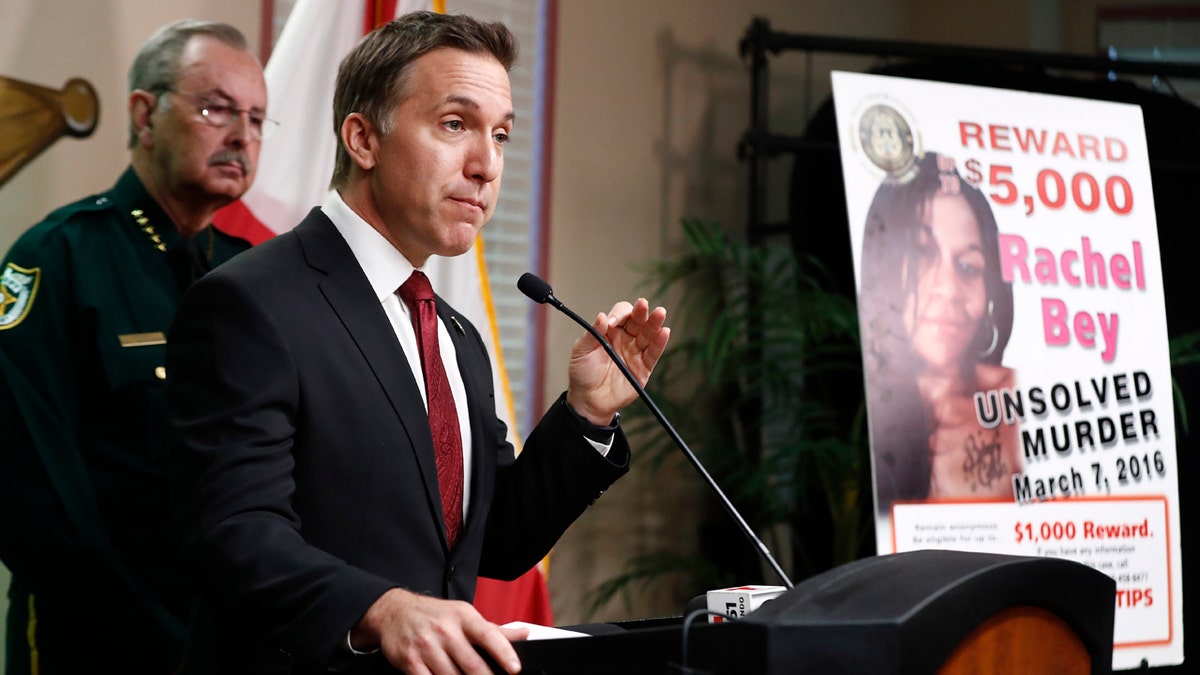Fox News Flash top headlines for Sept. 16
Fox News Flash top headlines for Sept. 16 are here. Check out what's clicking on Foxnews.com
A man charged with the murder of a woman in South Florida is now also a suspect in the deaths of at least three other women in the state, killed more than a decade ago. All the cases were linked to the man after cops collected DNA from a tossed cigarette butt, officials revealed Monday.
Robert Hayes, 37, was originally arrested and charged with first-degree murder in the death of 32-year-old Rachel Bey's, whose body was discovered along a road on March 7, 2016 near Jupiter, Palm Beach County Sheriff's Office announced.
"We've been able to take what we believe is a serial killer off our streets," Palm Beach County Sheriff Ric Bradshaw said at a news conference.
OHIO MAN ALLEGEDLY TIED TO 2 COLD CASE MURDERS, A YEAR AFTER ACQUITTAL IN 1991 SLAYING
Hayes appeared in court Monday for a brief hearing, where a judge denied him bail.
Bey was a prostitute and had her jaw broken in several places when she was found. Investigators said in court documents she had been killed elsewhere and dumped.
Officials were able to link Hayes to the killing of the 32-year-old by using a relative's DNA found on a popular online database to track him down. Investigators collected a cigarette butt last week after Hayes caught a bus and tested it after his arrest, reportedly generating results that showed 700-billion-to-1 odds that the killer is someone other than Hayes — a pool so large it's 100 times the world's population.

Dave Aronberg, state attorney for Palm Beach County, Fla., speaks during a news conference on Monday, Sept. 16, 2019, in West Palm Beach, Fla. Palm Beach County Sheriff's officials said they arrested 32-year-old Robert Hayes for first-degree murder in Rachel Bey's death. (AP Photo/Brynn Anderson)
As authorities in South Florida held a news conference to announce charges against Hayes, officials in Daytona Beach said at another press briefing that the 37-year-old was the suspect in the brutal killings of at least three other women dating back to a decade and a half ago.
"At this point in time, we have not charged him yet with ours, but we have linked him with forensic evidence to three of our murder victims," Daytona Beach Police Chief Craig Capri told reporters.
Capri, who referred to Hayes as a "disgusting serial killer," said that his name popped up earlier in the investigation as authorities had interviewed "hundreds" in connection with the killings in the city.
The first Daytona Beach body was discovered the day after Christmas 2005, when Laquetta Gunther, 45, was found in a gap between an auto parts store and a mostly empty utility building. Julie Green, 34, was found Jan. 14, 2006, on a dirt road at a construction site. The body of 35-year-old Iwana Patton was found Feb. 24, also on a dirt road.

Daytona Beach Police Chief Craig Capri referred to suspect Robert Hayes as a "disgusting serial killer." (FOX35)
Detectives believe the victims were shot in the head with a .40-caliber gun, and all three were discovered naked and face down on the ground, with their clothes either under them or found nearby.
“These were brutal crimes and the State Attorney’s Office is very fortunate to have the caliber of law enforcement folks that we have working these cases,” State Attorney R.J. Larizza told reporters in Daytona Beach
Police believe the victims willingly got into a car with the killer. Gunther had a police record for prostitution, but Green and Patton did not. Green had a record for drug possession, while Patton had several arrests for battery.
Investigators are also investigating if Hayes is linked to the death of a fourth woman, who was found dead under similar circumstances on Jan. 2, 2007, according to the Orlando Sentinel.
CLICK HERE FOR THE FOX NEWS APP
At the time of the Daytona Beach killings, Hayes was a student at the city's Bethune-Cookman University. Capri said it was only through advances in DNA technology that allowed detectives to link Hayes to the Daytona Beach murders.

Palm Beach County Sheriff Ric Bradshaw speaks during a news conference on Monday, Sept. 16, 2019, in West Palm Beach, Fla. (AP Photo/Brynn Anderson)
"All of these cases are linked by forensic evidence," Larizza said. "It's no longer working the streets anymore. It's working the technology, the DNA ... It's a brave new world."
The Daytona Beach killings caused such panic in 2006 that several prostitutes joined together to help with the investigation, memorizing vehicle descriptions and license plates, talking regularly with investigators and keeping a wary eye out for suspicious activity, according to the Associated Press.
The Associated Press contributed to this report.


